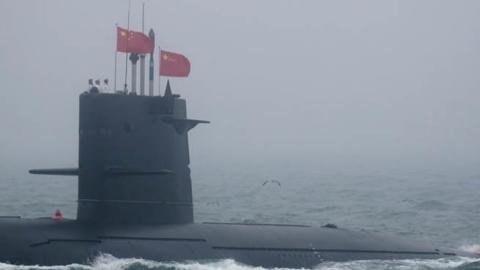While the world is distracted by the coronavirus pandemic, China has been quietly taking paramilitary and political-legal actions in the South China Sea that could be game-changing for the region. Betting that the United States is focused elsewhere and exhausted from years of Chinese encroachments, Beijing’s efforts are approaching an irretrievable tipping point. China aims to coerce its maritime neighbors to abandon their claims and territorial rights under international law and irrevocably alter the status quo. Beijing seeks to impose its so-called nine-dash line, an unrecognized boundary it has drawn around 85 percent of the South China Sea, almost all of it in international waters, and through which $3.4 trillion in shipped goods pass each year—freely, at least for now.
A bit like Russia in Crimea, Beijing is creating facts on the ground.
China’s claims to the disputed islets and reefs encompassing the Paracel and Spratly islands—which it calls Xisha and Nansha, respectively—have a questionable basis in international law and are based instead on an oval-shaped series of dashes drawn on map of the South China Sea. These islets, some of which Beijing has artificially reclaimed and fortified with military bases, overlap with claims by Malaysia, the Philippines, Vietnam, and Brunei. China’s line was originally drawn by the pre-Communist government of Chiang Kai-shek in 1947 and modified in 1952 by Mao Zedong. In 2009, in a diplomatic note to the Commission on the Limits of the Continental Shelf, China attached the dashed-line map and claimed that it had “indisputable sovereignty over the islands in the South China Sea and the adjacent waters, and enjoys sovereign rights and jurisdiction over the relevant waters as well as the seabed and subsoil thereof.” Beijing has pressed that claim with growing assertiveness ever since, all the while exploiting the ambiguity of terms such as “adjacent” and “relevant.”
Never mind that Beijing’s claims are fundamentally incompatible with established international law on maritime boundaries, the United Nations Convention on the Law of the Sea, which China has ratified and by which it professes to abide. Never mind, as well, that the claims have been ruled fraudulent by an international tribunal in The Hague. This is part of a broader Chinese strategy to create its own version of the Monroe Doctrine, the 19th-century policy by which the United States claimed all of North and South America as its rightful area of control at the exclusion of the European powers. Beijing seeks a sphere of decisive influence with military defense capabilities to raise the cost of any potential U.S. intervention. In short, while the world fights COVID-19, China is moving closer to establishing regional dominion.
These actions, and the response by the United States and the countries in the region, will determine whether the region’s future will be one of openness and shared prosperity or coercion and conflict.
Trying to create a fait accompli is the only way to interpret Beijing’s behavior in recent weeks. On April 18, China declared the establishment of two new administrative districts, one headquartered on Fiery Cross Reef, an artificial island in the Spratlys, and the other on Woody Island in the Paracels. It has named 80 islets and reefs, including not only artificial ones but also 55 entities that are permanently underwater. These actions are meant to create new facts to buttress claims to control the 1.4 million square miles of the South China Sea.
To enforce these claims over the past year, China has ramped up the pressure by using its three navies—the fleets of the People’s Liberation Army, China Coast Guard, and maritime militia—in waters off Indonesia, Malaysia, Vietnam, and the Philippines. Its illegal fishing has led Indonesia to step up naval actions, including sinking more than a dozen Chinese fishing boats around the Natuna Islands, internationally recognized to lie in Indonesian waters. Rather than back off, China resumed illegal fishing around the Natuna Islands at the end of March. While China does not dispute Indonesia’s sovereignty over the area, Beijing makes the absurd claim that these have been “traditional Chinese fishing grounds since ancient times,” as if Indonesian, Malaysian, or Vietnamese fishermen (whom Chinese vessels systematically harass) did not exist in the past.
More ominously, Beijing has been raising the stakes over the past year by threatening major offshore oil and gas projects inside Malaysia’s and Vietnam’s internationally recognized exclusive economic zones (EEZs). (A country’s EEZ extends 200 nautical miles off its shores.) In late April, a Chinese survey ship escorted by the China Coast Guard harassed an exploration vessel operated by the Malaysian energy giant Petronas inside Malaysia’s EEZ. The intimidation of the drillship followed similar standoffs last year. Before reaching Malaysia, the survey ship through Vietnam’s EEZ near the site of a previous incident. In 2019, Chinese and Vietnamese ships tried to block each other’s exploration of five offshore oil blocs inside Vietnam’s EEZ. This has raised worries in the region that China is trying to disrupt and gradually strangle Malaysian and Vietnamese oil and gas operations in the area and erase their territorial claims. The cost to Malaysia will be severe if Petronas has to pull the plug on important projects. Similarly, Hanoi fears that ExxonMobil and Rosneft might abandon projects in Vietnamese waters if Chinese harassment continues.
China’s gambit is an existential test of the United States’ position and credibility in Asia. Equally, China is challenging the Association of Southeast Asian Nations (ASEAN), which brings together countries opposed to Chinese expansion but with little record of standing up to Beijing with anything other than rhetoric and diplomacy. The United States has no territorial claims but an enduring vital interest in freedom of navigation. To date, the U.S. response to China’s bellicosity has been mainly diplomatic condemnation and a ramping up of so-called freedom of navigation operations by the U.S. Navy in international waters claimed by China. These operations are necessary but not sufficient, as they have had no visible impact on Chinese behavior so far. Similarly, while ASEAN wags its finger at Beijing, the organization has spent nearly 20 fruitless years trying to negotiate a code of conduct for the South China Sea with Beijing.
The central role in standing up to China will fall on ASEAN, a potentially powerful alliance of 10 nations with 625 million people and nearly $3 trillion in combined GDP. But because ASEAN’s decisions require unanimous consent, forceful action has been blocked by two of its members, Cambodia and Laos, that are beholden to Beijing—giving China a de facto veto in the bloc. ASEAN needs to reinvent its decision-making process or risk irrelevance. If ASEAN cannot find the will to act as a bloc, then those ASEAN members that do want to act should form a maritime bloc as a coalition of the willing
Bolder Asian action also requires reliable U.S. leadership. Regional players fear that provoking China will result in economic coercion. But Beijing’s recent actions have spurred an unusually strong reaction from maritime ASEAN states fearing permanent Chinese pressure. Sea-bordering Southeast Asian countries are acutely aware that inaction risks giving Beijing permanent control over economic and military activities in the South China Sea—which would be a mortal blow to their strategic autonomy. The time is therefore ripe for a U.S.-led coalition. The United States, Japan, and Australia would be wise to take the lead in crafting a code of conduct for the Western Pacific based on recognized international law and established maritime legal institutions.
If ASEAN can take collective action, China’s power over its member countries will dissipate. Conversely, Beijing’s bullying tactics are most effective when it successfully divides and isolates its neighbors. After the China Coast Guard sank a Vietnamese ship and injured eight fishermen on April 3, the Philippine Foreign Affairs Department took the rare step of expressing support for Vietnam. Beijing took note. Similarly, it made a difference when Vietnam rescued Filipino fishermen who were stranded last year after a suspected Chinese maritime militia vessel sank their boat.
Preventing the Western Pacific from turning into a China-owned lake requires working together to defend partners and international law. Maritime states like the Philippines, Vietnam, Indonesia, Malaysia, and Brunei should enhance cooperation by coordinating their coast guard operations, increasing their sharing of intelligence, and reaching an accord on how their overlapping South China Sea maritime boundaries should be demarcated.
Meanwhile, the United States should act as a catalyst for the region’s defense by funding the bipartisan congressional Indo-Pacific Deterrence Initiative, which would provide military funding and build on earlier efforts. If Beijing’s South China Sea gambit succeeds, it would be a ruinous blow to U.S. credibility, rippling across U.S. alliances and partnerships in the region. China understands the stakes and so must ASEAN and the United States.
Read in Foreign Policy



















